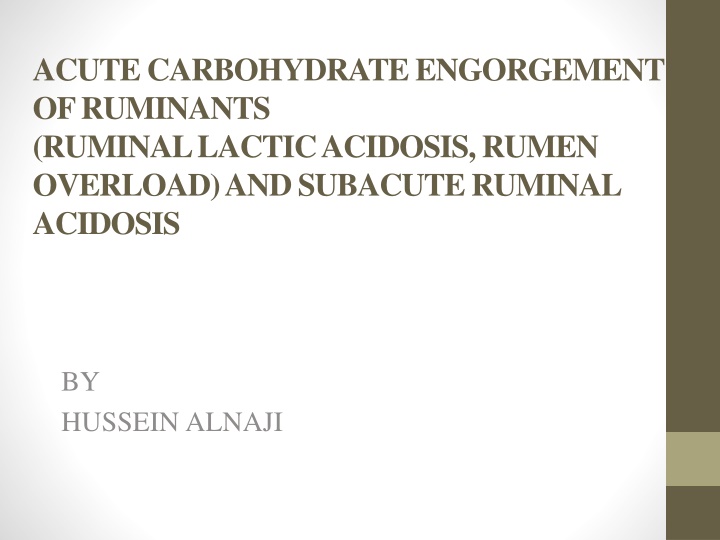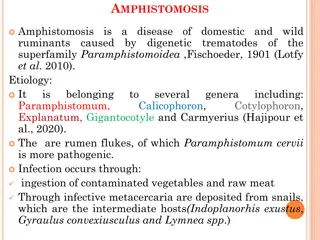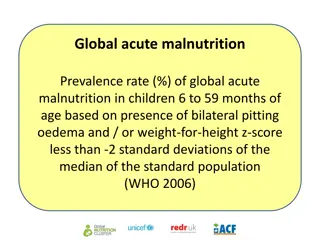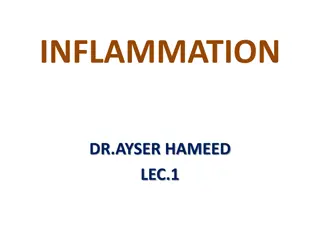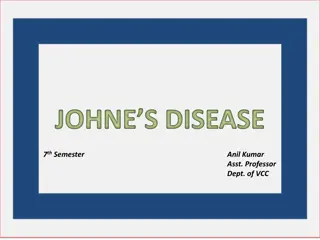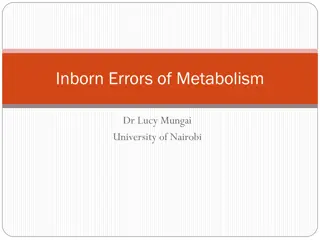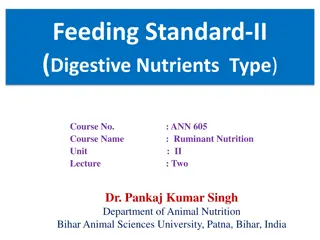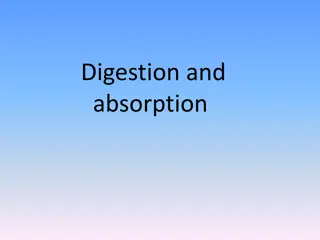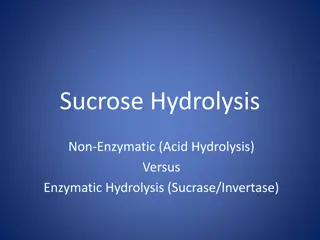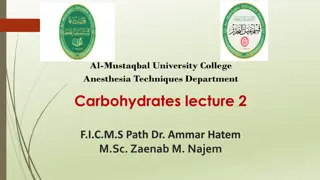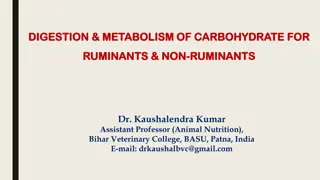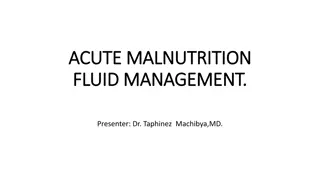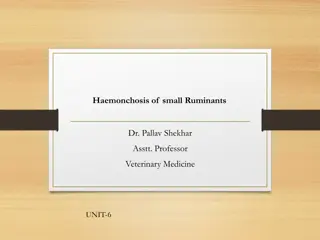Acute Carbohydrate Engorgement in Ruminants
Acute carbohydrate engorgement in ruminants is often caused by the sudden ingestion of toxic doses of carbohydrate-rich feed, leading to conditions like acute ruminal acidosis. Subacute ruminal acidosis (SARA) in dairy cattle is another disorder resulting from imbalanced nutrition. The pathogenesis involves changes in rumen microflora, volatile fatty acids increase, and systemic lactic acidosis. Identifying and managing these conditions are crucial for animal health and welfare.
Download Presentation

Please find below an Image/Link to download the presentation.
The content on the website is provided AS IS for your information and personal use only. It may not be sold, licensed, or shared on other websites without obtaining consent from the author.If you encounter any issues during the download, it is possible that the publisher has removed the file from their server.
You are allowed to download the files provided on this website for personal or commercial use, subject to the condition that they are used lawfully. All files are the property of their respective owners.
The content on the website is provided AS IS for your information and personal use only. It may not be sold, licensed, or shared on other websites without obtaining consent from the author.
E N D
Presentation Transcript
ACUTE CARBOHYDRATE ENGORGEMENT OF RUMINANTS (RUMINAL LACTIC ACIDOSIS, RUMEN OVERLOAD) AND SUBACUTE RUMINAL ACIDOSIS BY HUSSEIN ALNAJI
ETIOLOGY Acute ruminal acidosis is most commonly caused by the sudden ingestion of toxic doses of carbohydrate-rich feed, such as grain. Subacute ruminal acidosis (SARA) in dairy cattle is a disorder of ruminal fermentation in dairy cattle caused by the ingestion of large amounts of concentrates and low level amounts of fiber administered to increase milk production in early lactation. SARA results from continued ingestion of these feeds over a prolonged period rather than sudden exposure without adequate adaptation.
Pathogenesis First stage (Changes in Rumen Microflora) increase Streptococcus bovis, which use the carbohydrate to quantities of lactic acid in the number of The ingestion of excessive quantities fermentable feeds of highly 4-6 h produce large 2- Second stage (increase Volatile Fatty Acids and low the pH in Rumen) decreases the rumen pH to 5 or less, which results in the destruction of the cellulolytic bacteria and protozoa. Increase of lactobacilli and produce excessive quantities of lactic acid, resulting in ruminal lactic acidosis Increases ruminal osmolality, water is drawn in from the systemic circulation, causing hemoconcentration dehydration and
The amplitude and frequency of the rumen contractions are decreased, ruminal atony and absorbed lactic acid to blood 3-third stage Systemic Lactic Acidosis or acidemia Two type of lactic acid D-lactate is very slowly metabolized and plasma concentrations decrease primarily by renal excretion, which is low in advanced cases of ruminal acidosisbecause dehydration The metabolized causes increasing blood pH toward the normal range L-lactate is bicarbonate, rapidly to Or of marked In severe cases of lactic acidosis the plasma bicarbonate reduced, the blood pH declines, and the blood pressure and renal blood flow decline, Causing a decrease in perfusion pressure and oxygen peripheral tissues. . are supply to
Increase in lactic acid from cellular respiration and decreased elimination of d- lactate in the urine.. If survive Hepatic Abscesses- to rumenitis caused by lactic acidosis and allowing Fusobacterium necrophorum Arcanobacterium or Corynebacterium) pyogenes to enter directly into ruminal vessels and spread to the liver, Chemical Mycotic Rumenitis du to - low pH rumen favors the growth of Mucor, Rhizopus, Absidia spp., . and due Laminitis. Vasoactive substances released during the decline of rumen pH and the bacteriolysis and degradation. due to are of the and and tissue
Clinical signs A. Peracute 1. Severely depressed, weak , in lateral recumbency , unable to stand , apparent blindness , pupils dilated and slow response. 2. Severe dehydration (8-12), tachycardia 110-130 b/m 3. The temperature is usually below normal, 36.5 C to 38.5 C. 4. Rumen distended with fluid and soft rumen contents, complete stasis, sweet sour smelling fluid contents Rumen juice pH below 5 and usually about 4 No protozoa. 5. The treatment : Rumenotomy Sodium bicarbonate 5 L (5%) IV in 30 min (for 450 kg BW) followed by isotonic balanced fluids and electrolytes at 150 mL/kg BW for 6 12 h.
B.Acute 1. Depressed, still able to walk but ataxic, complete anorexia, may want to drink water, pupils slightly dilated and slow response. 2. Degree of dehydration 8-10%, the heart rate 90- 100 and normal body temperature. 3. Rumen distended with fluid, complete stasis, sweet sour smelling fluid contents Rumen pH between 5 and 6 No protozoa. 4. Treatment: Consider immediate slaughter Rumen lavage or rumenotomy Sodium bicarbonate and fluids IV as in peracute case Feed hay.
C. Subacute 1. Fairly bright and alert , able to walk, no ataxia , may eat, usually wants to drink, pupils normal. 2. Mild or normal dehydration, normal body temperature and heart rate. 3. The rumen Moderate distension with fluid, some doughy ruminal ingesta palpable, some weak ruminal contractions , rumen pH between 5.5 and 6.5Some protozoa alive. 4. Treatment: Magnesium hydroxide 500g/450 kg BW into rumen Fluids if indicated Feed hay Should begin eating in 24 36 h.
Note1 : The heart rate in cattle is usually increased and continues to increase with the severity of the acidosis and circulatory failure. Generally, the prognosis is better in those with heart rates below 100 beats/min than those with rates up to 120 to 140 beats/min. In sheep and goats, the heart rate may be higher than 100 beats/min. Note 2: Anuria is a common finding in acute cases, and diuresis following fluid therapy is a good prognostic sign.
Complications 1. Chronic laminitis may occur several weeks or months later. 2. Abortions may occur 10 days to 2 weeks later in pregnant cattle. 3. Chemical and Mycotic Rumenitis. 4. HepaticAbscesses.
Clinical pathology The pH of the ruminal fluid obtained by specially designed stomach tubes or by rumenocentesis through the left ventral abdominalregion 1. Rumenal fluid pH : normal rumen pH 6-7> 2. Ruminal Protozoa:Microscopic examination of a few drops of ruminal fluid on a glass slide (with a coverslip ( at low power will reveal the absence of ruminal protozoa. 3. Serum Biochemistry: The degree of hemoconcentration, as indicated by hematocrit. 4. Urine pH: The urine pH falls to 4.5 to 5.0 in advanced cases of acute ruminal acidosis. 5. Low Milk-Fat Percentage.
